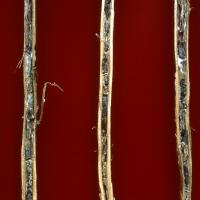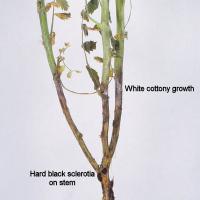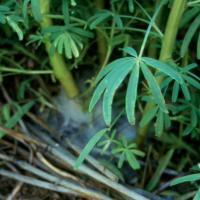Diagnosing sclerotinia white mould in pulse crops
Two fungi which cause similar diseases referred to as sclerotinia white mould are Sclerotinia sclerotiorum and Sclerotinia minor. These may occasionally cause reductions in plant density in well-grown crops after flowering and are mainly seen in the higher rainfall zones (>400 mm). Chickpeas is the most susceptible pulse crop sown in Western Australia, followed by lentils. Faba bean and field peas are the least susceptible.
What to look for
- Whole plants or branches that wilt and die in spring due to stem lesions that girdle the stem.
- Lush, wet crops are most affected.
Paddock
- The fungus produces a white cottony-looking growth that girdles the stem, causing the plant parts above the lesion to wilt and die.
- Sclerotinia minor (sclerotinia collar rot) lesions occur near ground level. The fungal growth contains small black fruiting bodies, about the size of a pinhead called sclerotia.
- Sclerotinia sclerotiorum (sclerotinia stem rot) lesions may occur in the upper half of the main stem, branches, and on flowers and pods. Individual pods or complete flower spikes can be completely covered by white fungal growth. Hard black sclerotia, 2-8 mm in diameter, are produced in the fungal growth or in the cavities of infected stems or pods.
Plant
Where did it come from?

Contaminated soil

Alternate host

Wet conditions

Susceptible varieties
- Sclerotinia survives as sclerotia (hard, dark resting bodies) in the soil for many years, and infects many broadleaf crops and weeds.
- Collar rot sclerotia germinate under suitable environmental conditions and infect plants as fungus grows out from the sclerotia.
- Stem rot sclerotia near the surface germinate and produce small, cream, mushroom-like bodies (apothecia) containing many spores that are carried by wind to nearby crops.
- Normally the spore must first germinate on, then infect, dead or dying plant material (such as flower petals) before it invades healthy tissues.
- Infected petals that lodge between the stems and leaves are a major infection source. Cool, wet weather favours the disease and mists, dews and fogs provide enough moisture for infection.
- Canola is highly susceptible to Sclerotinia stem rot. Lupins and chickpeas are commonly infected whereas faba beans and field peas appear to be less susceptible
Management strategies

Rotation

- Crop rotation can have some effect, although sclerotia survive for significant periods. Cereals are non-hosts and provide the most effective disease break.
- Avoid sowing lupins in close rotation with other broad leaf crop species such as canola.
- Foliar fungicides are not currently registered for sclerotinia in lupins.
See also
Where to go for expert help
Page last updated: Wednesday, 1 July 2015 - 11:15am





